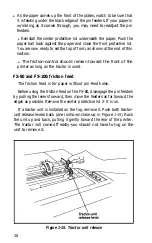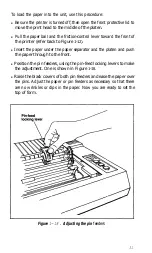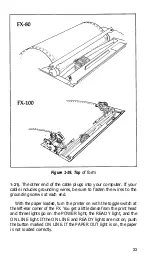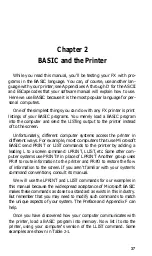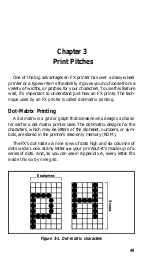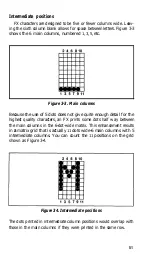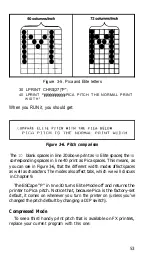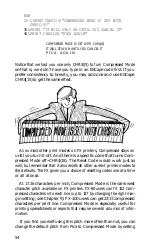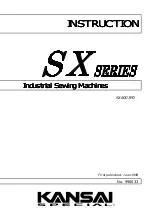
Character strings
The character-string (or CHR$) function converts any decimal
number from zero through 255 to a character or action. Its format is
CHR$ followed by a number in parentheses, for example, CHR$(84).
The character-string command follows a PRINT or LPRINT com-
mand and causes your computer system to send an ASCII code to the
computer’s screen or to the printer. What gets printed or performed is
determined by the particular modified ASCII table that is used by
your system. Where the printing or action happens-on your screen
or your printer-depends on the print command that precedes the
character-string command.
For a fast check on what your computer does with this function, try
printing a few characters on your computer’s screen. The usual format
for this is PRINT CHR$(n). The n represents one of the numbers from
zero to 255, each one of which accesses a unique character or action.
Try typing this:
10 PRINT CHR$(65)
and RUNning it. Since most computers use the numbers from 32 to
127 to mean the ASCII set of characters, you should see a capital A on
the screen.
It’s the numbers less than 32 and greater than 127 that produce
different results on nearly every brand of computer. Try entering:
10 PRINT CHR$(193)
and RUNning it. If you don’t see anything on the screen, don’t worry.
Remember that this was just a quick check. We are mainly interested
in sending that 193 to the printer, and what it prints on the screen is
not as important right now.
BASIC print commands
Well then, what happens when you send such a non-standard code
as 193 to the printer? To test this out, you need to know what program
commands your computer uses to activate the printer. Some typical
command sequences are shown in Table 2-2.
39
Summary of Contents for FX-80
Page 1: ......
Page 22: ......
Page 23: ......
Page 26: ......
Page 31: ...Figure 1 1 The FX 80 and FX 100 printers 14 ...
Page 32: ...Figure 1 2 Printer parts 1 5 ...
Page 38: ...Figure 1 8 DIP switch vent 21 ...
Page 42: ...Figure 1 11 Ribbon insertion 25 ...
Page 51: ...Figure 1 20 Paper thickness adjustment 34 ...
Page 85: ......
Page 92: ......
Page 95: ......
Page 97: ...80 ...
Page 109: ......
Page 117: ...Figure 7 3 Staggering STAIR STEPS 100 ...
Page 119: ...Table 7 1 Line spacing commands 102 ...
Page 129: ...112 ...
Page 147: ...130 ...
Page 181: ...Figure 12 4 Corner of the FX 80 design ...
Page 189: ...Figure 12 10 Most distinct version Figure 12 11 Reversed version 172 ...
Page 215: ...198 ...
Page 231: ...214 ...
Page 249: ......
Page 269: ......
Page 272: ...iv ...
Page 283: ......
Page 290: ......
Page 305: ...282 ...
Page 311: ...288 ...
Page 323: ...300 ...
Page 339: ......
Page 343: ...320 ...
Page 349: ...326 ...
Page 353: ...330 ...
Page 354: ...Schematic 331 ...




